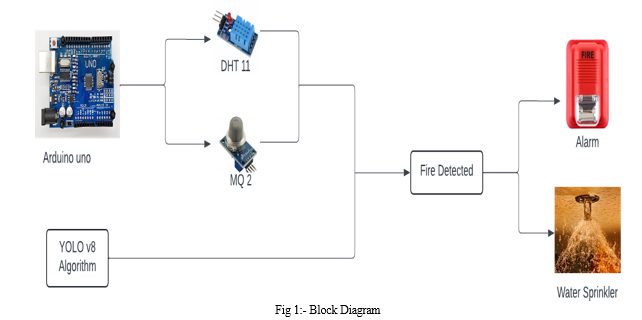Ijraset Journal For Research in Applied Science and Engineering Technology
- Home / Ijraset
- On This Page
- Abstract
- Introduction
- Conclusion
- References
- Copyright
Integrated Fire Detection System using ML and IOT
Authors: Swapnil Sawant, Bhakti Chauhan, Samarth Kumbhar, Gaurav Chaudhari, Prachi Thakkar
DOI Link: https://doi.org/10.22214/ijraset.2024.61810
Certificate: View Certificate
Abstract
An integrated fire detection system that combines smoke, thermal, and image analysis using machine learning can provide real-time fire detection and reduce false alarms, thereby enhancing safety. Traditional single-sensor fire detection systems that rely on smoke or heat often result in false alarms or delays. The proposed multi-model system involves combining smoke, thermal, and YOLO v8 image detection technologies. However, challenges such as data privacy, cost, and maintenance need to be addressed. Nevertheless, this advanced fire detection system has the potential to significantly improve fire protection.
Introduction
I. INTRODUCTION
Traditional fire detection systems have been the go-to solution for building safety for a long time. These systems rely on reliable technologies like smoke and heat detectors to detect potential fire hazards. Smoke detectors come in two main types: photoelectric and ionization. Photoelectric detectors use a light beam to sense disruptions caused by smoke particles, while ionization detectors rely on electrical currents that get disrupted by smoke's presence. Both types trigger a loud alarm upon detection to warn occupants. Heat detectors, on the other hand, contain a heat-sensitive element that triggers an alarm when there's a rapid or extreme temperature increase, which can signify a fire even before smoke develops. While these traditional systems are effective, they do have their limitations. Buildings are often divided into zones with multiple detectors wired together. When one detector gets activated, it triggers the entire zone's alarm, which is great for large spaces but lacks precision. Evacuating a whole floor for a fire in a single room is not ideal! Additionally, these systems can't pinpoint the exact location of the fire, making it harder for firefighters to locate the source quickly.
Despite these drawbacks, traditional fire detection systems remain popular because they are simple and affordable compared to newer technologies. They offer a proven layer of protection, even with their limitations.
Fire detection is crucial for protecting lives and property from the destructive consequences of fires. Smoke detectors, which are the most commonly used, act as the first line of defense. These devices use photoelectric or ionization technology to detect smoke particles and trigger a loud alarm to alert occupants. Heat detectors, another prevalent technology, work differently. They monitor for rapid or extreme temperature increases, which may signal the presence of a fire even before smoke accumulates. Fire detection has gone beyond traditional sensors, with modern systems using video cameras and complex algorithms to visually identify flames. This multi-pronged approach, with smoke, heat, and visual detection, significantly increases a system's ability to raise an alarm in the early stages of a fire. Early detection is essential, as it provides ample time for occupants to evacuate safely and emergency services to be alerted. By implementing a comprehensive fire detection system, you significantly increase your chances of preventing a fire's harm.
Fire detection is on the brink of a high-tech upgrade with YOLOv8, a cutting-edge image recognition system. Unlike traditional detectors that rely on heat or smoke signatures, YOLOv8 uses cameras and artificial intelligence to detect fires. By training on a massive dataset of images containing flames and smoke, YOLOv8 is capable of recognizing these visual cues in real-time video streams. This means that fire detection can be faster and more accurate, especially in situations where traditional methods may not work. Imagine identifying a small fire with just a wisp of smoke before it becomes a major blaze. The advantages are clear: faster response times can make all the difference between a minor scare and a catastrophic fire. YOLOv8 can cover wider areas with ease, making it ideal for safeguarding larger spaces or multiple buildings. Additionally, this technology can be integrated with automated systems, triggering alarms or deploying fire suppression measures the moment a fire is detected - a crucial advantage in situations where every second counts. However, to make the most of YOLOv8, a high-quality dataset is necessary for effective training, and some technical expertise is required for setup and implementation. But with these considerations taken care of, YOLOv8 offers a glimpse into the future of fire detection, providing faster, more intelligent protection for our homes and businesses.
II. LITERATURE SURVEY
This paper uses camera networks for early wildfire detection. It suggests a two-pronged strategy: an ideal camera placement plan to optimize coverage within financial restrictions, and a lightweight smoke detection program for on-camera analysis employing image processing. Real-world testing has proven the smoke detection and placement techniques, which makes this a potentially useful technology for faster wildfire response times and less damage.
In order to address the growing worry about fire mishaps, this article suggests an IoT-based real-time fire detection system. The system makes use of a number of sensors to gather information on smoke, temperature, humidity, and even building occupancy. A dashboard that is easy to use is then used to remotely monitor this data. Crucially, in the event that any reading surpasses safety standards, the system initiates multi-level alarms (light, buzzer, SMS). Its potential to count people, which helps with evacuations, is a special feature. The study ends with encouraging test findings and suggests further developments utilizing AI and camera integration for improved fire detection in the future.
This study examines developments in fire detection with a focus on fire safety. Although deep learning in computer vision presents a promising alternative, traditional methods have drawbacks. The study examines current deep learning fire detection methods and outlines YOLOv5's benefits. The experiment to develop a prototype fire detection system utilizing YOLOv5 and PyQT5 is then described. The experiment shows that YOLOv5 obtains higher accuracy in detecting fires.
Accurate fire detection in infrared photographs is a persistent difficulty faced by building owners and firefighters. Despite their importance, these photos frequently have poor resolution and insufficient information, which causes false alarms and missed fires. In order to address these constraints, a novel deep learning technique is put forth in this study. The technique includes two major modifications: it integrates CSP_ResNet and SPP networks to efficiently extract even minute fire details from the full image, and it swaps out pooling layers with convolutional layers to preserve features. The suggested model achieves a substantially reduced false alarm rate and a stunning 94.35% fire detection accuracy (mAP) using a custom dataset – a 6.06% improvement over existing methods. Experiments verify considerable improvements. The potential for this creative strategy to greatly improve fire safety through more accurate fire detection in infrared imaging.
III. MOTIVATION
Fire alarms traditionally relied on manual activation or heat detection, which can be slow and insensitive. However, with the integration of ML-powered IoT systems, there is now a highly effective alternative. These systems utilize a network of sensors and cutting-edge ML algorithms to detect fire signatures with exceptional speed and precision. The use of such systems can significantly reduce response times, minimize property damage, and most importantly, save lives. Additionally, the data collected by these systems can help identify fire risks and improve preventative measures. In short, with ML-powered IoT systems, we can now confidently rely on advanced fire detection and response capabilities.
IV. PROPOSED SYSTEM
The proposed integrated fire detection system aims to elevate fire protection to a new level by combining the strengths of multiple sensing technologies and advanced image processing algorithms. This synergistic approach addresses the limitations of individual detection methods and enhances overall system accuracy and reliability.
By integrating all three detection modalities, the proposed system overcomes the shortcomings of individual methods and provides a more comprehensive and reliable fire detection solution.
Smoke detection alerts the system to the presence of combustion, while thermal detection identifies the rapid temperature increase associated with fire. Additionally, YOLO v8 image detection provides visual confirmation of fire-related objects, enhancing the system's confidence level and reducing false alarms.
The proposed system's architecture involves a tiered approach. Smoke and thermal detectors are deployed throughout the protected area, continuously monitoring for smoke and temperature changes. Video surveillance cameras capture real-time footage of the environment, which is fed into the YOLO v8 object detection algorithm.
When a smoke detector or thermal sensor detects a potential fire hazard, it sends an alert to the central control unit. Simultaneously, the YOLO v8 algorithm analyzes the video feed, searching for fire-related objects. If the central control unit receives alerts from multiple sources or if YOLO v8 confirms the presence of fire, the system triggers an alarm, activating evacuation protocols and notifying emergency responders.
A. Block Diagram
The fire detection system is composed of several components that work hand-in-hand to accurately identify fire. These components include thermal sensors, smoke detectors, a machine learning algorithm, surveillance camera, and fire alarm. Thermal sensors are designed to detect heat radiating from objects and can detect fire even in low-light or smoky conditions. Smoke detectors, on the other hand, sense smoke particles in the air, which is a clear sign of fire. The machine learning algorithm is the core of the system, and it's likely based on You Only Look Once (Yolov8) that has been trained on a vast dataset of images and videos containing fire and non-fire scenarios.
The Yolov8 can distinguish fire from other elements in an image or video frame. The surveillance camera captures visual data of the environment, which the machine learning algorithm uses to identify fire based on visual features like flames or smoke. Lastly, when the system detects fire, it triggers an alarm to notify people in the vicinity.
Overall, this machine learning system offers a comprehensive approach to fire detection by combining thermal and smoke sensing with visual inspection through a camera. It has the potential to improve fire detection accuracy and speed by utilizing machine learning algorithms.
V. IMPLEMENTATION DETAILS
A. System Requirements
- Hardware Requirements
Processor: Intel Core i5 or equivalent RAM: 8GB or more
GPU: NVIDIA GeForce RTX 2060 or equivalent Arduino uno
Camera: Web Camera
Smoke Detector: MQ2 (Smoke detectors with data output capabilities) Thermal Sensor: DHT 11 (Thermal sensors with data output capabilities) Relay module
Buzzer
Water Pump Module (as a Sprinkler)
2. Software Requirements
- Operating System: Windows/Linux Programming Language: Python & C++ Libraries: Ultralytics, OpenCV, Serial
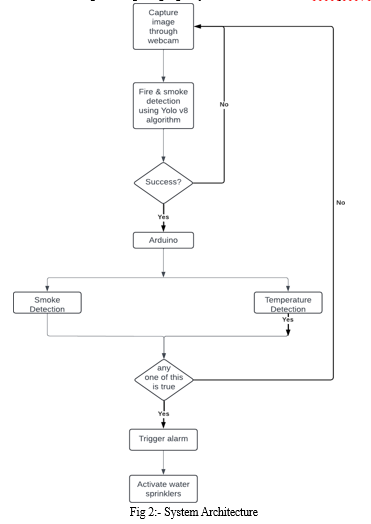
2. YOLOv8
YOLOv8 is a state-of-the-art computer vision model that is specifically designed for object detection. It is the latest iteration of the famous YOLOv5 model, developed by the same team, Ultralytics. YOLOv8 is highly proficient in identifying and locating objects within images. In comparison to other detection systems, YOLOv8 doesn't rely on pre-defined anchors for objects, which makes it more versatile in recognizing objects of various sizes. Moreover, the model divides tasks within itself, which leads to improved accuracy. YOLOv8 comes with a user-friendly Python package and command-line interface, making it accessible for various applications.
Steps:
a. Prepares the image (resizing, color adjustments).
b. Splits the image and analyzes parts for object clues.
c. Uses different "zoom levels" to find various object sizes.
d. Predicts object location (bounding boxes) and class (labels) with confidence scores.
e. Outputs a report of detected objects with bounding boxes, labels, and confidence scores.
3. Arduino
Arduino is an electronics platform that is open-source. It enables hobbyists, students, and professionals to create interactive projects with ease. The platform combines user-friendly hardware and software. The hardware is made up of physical circuit boards, called microcontrollers, which have built-in brains. On the other hand, the software, known as the Arduino IDE, runs on your computer and allows you to write simple code that instructs the microcontroller what to do. Arduino boards can detect their surroundings by using buttons, sensors, and cameras and then control outputs such as LEDs, motors, and even the internet. This versatility, combined with the affordability of the platform and the large online community for support and project ideas, makes Arduino a powerful tool for turning your electronic creations into reality.
4. Smoke Sensor (MQ2)
The MQ-2 sensor is a cost-effective gas detector that is perfect for detecting smoke and flammable gases. It operates by utilizing a metal oxide semiconductor that responds to these gases by altering its electrical resistance. This alteration indicates a potential fire danger. Although it is not extremely precise, its affordability makes it a popular option for air quality monitors and basic fire alarms.
5. Thermal Sensors
Thermal sensors are different from smoke detectors in that they silently monitor temperature changes and can detect fires even before smoke is produced. This makes them particularly useful for detecting electrical fires. However, they can be tricked by sudden changes in temperature, so it's best to use them in conjunction with smoke sensors for a more reliable fire detection system.
6. System Workflow
Our state-of-the-art system is designed to keep you and your property safe from potential fire hazards. Here's how it works:
a. Frame Capture: Our system captures frames from your webcam at regular intervals.
b. Object Detection: The frames are then analyzed using the YOLOv8 model to detect any objects in the vicinity.
c. Fire/Smoke Detection: The system checks the YOLOv8 model's output for the presence of fire and smoke, using advanced algorithms to analyze class names and confidence scores.
d. Serial Communication (if Fire Detected): If fire is detected with a high confidence score: The system sends a signal through the serial port to the Arduino board.
e. Arduino Actions (upon receiving signal):
The Arduino checks for sensor readings from:
-
- Temperature sensor: If temperature exceeds a threshold, it indicates a fire hazard.
- Smoke sensor: If smoke is detected, it suggests a potential fire.
If either smoke or high temperature is detected (or both):
-
- The Arduino triggers an alarm to alert people.
- Also, the Arduino activates water sprinklers to extinguish the fire automatically.
VI. RESULT EVALUATION AND COMPARATIVE ANALYSIS
A. Comparative Analysis
|
Model |
Algorithm description |
Pros |
Cons |
|||
|
Convolutio nal neural networks (CNNs) |
CNNs are a kind of deep neural network that excel in tasks involving image processing. By training on photos, they have been used to detect flames by recognizing characteristics like color and texture that are typical of fires. |
CNNs are relatively simple to implement and can achieve high. accuracy when trained on large datasets. They can also identify fires in real time. |
CNNs may struggle with detecting fires in images with complex backgrounds or in low-light conditions. They also require large amounts of data for training, which can be time- consuming and expensive. |
|||
|
Recurrent neural networks (RNNs) |
RNNs are a type of neural network that are designed to handle sequential data, such as time-series data. They are used for fire detection by training on video frames and identifying patterns that indicates fire. |
RNNs can capture temporal dependencies in the data, which can improve their accuracy in detecting fires in videos. They are also flexible and can be used for a wide range of tasks, including speech recognition and natural language processing. |
RNNs can be computationally expensive and may struggle with long-term dependencies in the data. They require large training data. |
|||
|
YOLOv2 |
YOLOv2 is a DL algorithm that uses a single neural network to predict bounding boxes and class probabilities for objects in an image. It has been used for fire detection by training on images and identifying features that are common to fires, such as color and texture |
YOLOv2 can achieve high accuracy in object detection tasks and can process images in real time It is also relatively simple to implement |
It may also struggle with detecting fires in images with complex backgrounds. It may also require large amounts of data for training |
|||
|
|
YOLOv3 |
YOLOv3 is an updated version of YOLOv2 that uses a more powerful neural network architecture and incorporates additional features, such as feature pyramid networks and residual connections. |
YOLOv3 can achieve high accuracy in object detection tasks and can process images in real time It is also more robust than YOLOv2 and can handle complex backgrounds and low-light conditions |
It require larger computational resources compared to YOLOv2. |
||
|
|
YOLOv4 |
YOLOv4 is a further updated version of the YOLO algorithm that incorporates several new features, such as spatial attention modules and swish activation functions. |
YOLOv4 can achieve high accuracy in object detection tasks and can process images in real time Additionally, it is more durable than earlier iterations of YOLO and is capable of handling complicated backgrounds and dim lighting. |
It also requires larger amounts of computational resources compared to previous versions of YOLO. |
||
|
|
YOLOv5 |
A newer iteration of the YOLO method called YOLOv5 adds autoanchor optimization and multi- scale prediction along with a lightweight network architecture. |
Faster and more accurate than YOLOv4 Smaller and simpler architecture Three versions with different model sizes and complexities State-of-the-art performance on multiple object detection benchmarks |
Still needs a lot of data for training, and false regressions could be an issue.
May not be able to detect small items or objects with intricate shapes. |
||
The table presents a comparative study of the most common models used in the fire detection industry. Nevertheless, there are still certain unanswered questions and drawbacks with these models. For example, the CNNs might have trouble identifying fires in photos with complicated backgrounds or in low light.
The RNNs, on the other hand, might be computationally costly, have trouble with long-term dependencies in the data, and need a lot of training data.
- YOLOv2 may need a lot of data for training and may have trouble identifying flames in photos with complicated backdrops or in low light.
- Compared to YOLOv2, YOLOv3 might need more processing power.
- Compared to earlier iterations of YOLO, YOLOv4 might demand significantly more computer power.
- Yolov5 still has problems in detecting small items or objects with complicated shapes, and it still needs a lot of data for training. It may also suffer from erroneous regressions.
Deep learning-based techniques for fire detection have advanced, however there are still certain issues that need to be resolved. For training and evaluating these methods, for instance, more varied and sizable datasets are required. Furthermore, bad lighting or the usage of subpar cameras might have an impact on how accurate fire detection systems are.
This paper proposes a YOLOv8-based fire detection method. To the best of our knowledge, this is the first study looking into IFDS fire detection using the YOLOv8 algorithm. The suggested method aims to address some constraints of earlier research and offer enhanced precision, instantaneous identification, adaptability, reduced false alerts, and economical effectiveness.
The YOLO collection of algorithms has gained interest in computer vision. Because it maintains a high level of accuracy while maintaining a small model size, YOLO is quite popular. YOLO models may be trained on a single GPU, making them accessible to a broad range of developers. Machine learning professionals might easily install it on edge hardware or in the cloud. YOLOv8, the most advanced and newest YOLO technique, can be used for segmentation, object recognition, and image classification, among other applications. Yolo v8 was created by Ultralytics, the same company that created the important YOLOv5 model that helped to define the market. There are various architectural upgrades and improvements in YOLOv8 over YOLOv5.
B. Used Dataset
The dataset comprises a wide range of fire and smoke scenarios, both indoor and outdoor, small and large, captured under low-light and high-light conditions. Additionally, it includes normal scenes without fire. The dataset contains a total of 2,834 images, with images containing fires, smoke, fire and smoke, and normal scenes without fire or smoke.
The dataset is divided into three categories - 2,277 images for training, 371 images for validation, and 186 images for testing. The proposed method has demonstrated its superiority in smoke and fire detection with high accuracy. Moreover, it can also generalize and validate new images with very high accuracy.
C. Performance Metrics
A YOLO v8 model was trained on a dataset that was annotated on Roboflow and trained on a personal system. The model was trained for 50 epochs with a batch size of 16 and an initial learning rate of 0.01. We implemented, trained, and validated the proposed model on Google Colab using a GPU platform. According to the experimental results, our model can detect fires with a precision of 95.7% and smoke with a precision of 99.3%, resulting in an overall mean average precision (mAP) of 97.5% for the two classes. Figure 3 shows the overall results of the proposed model, including loss, precision, and recall, while Figures 4 and 5 show the precision- recall curve. Additionally, Figure 6 presents the results of fire and smoke detection with the proposed model.
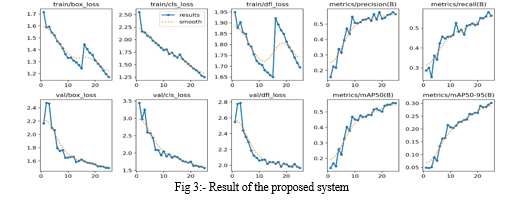
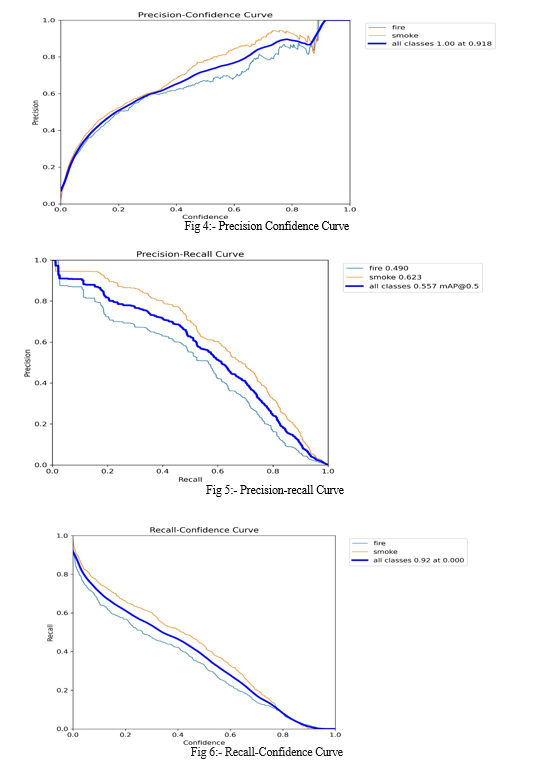
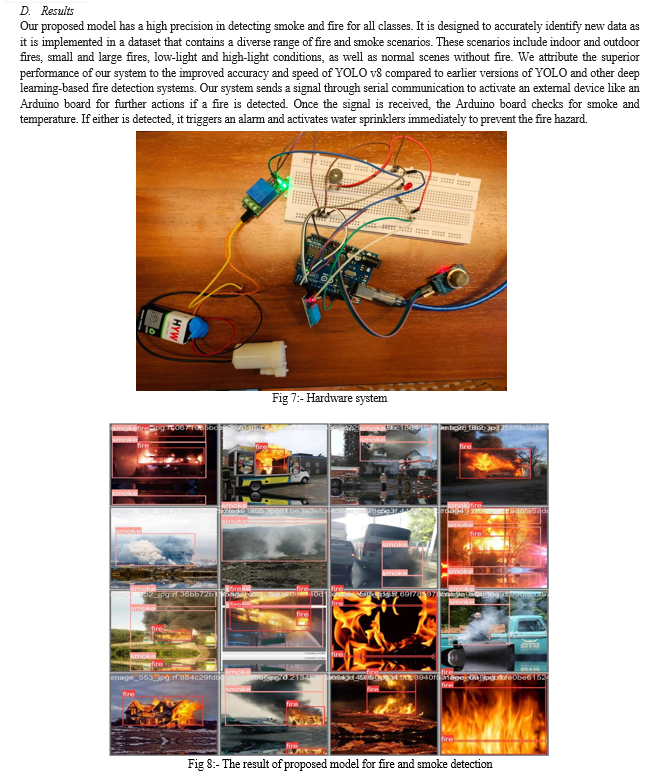
VII. FUTURE SCOPE
The future of fire detection seems to be promising with YOLOv8. Imagine a system that not only detects fires but also identifies their type and size, predicts potential outbreaks, and dispatches robots for faster suppression. This technology can be integrated with smart home devices and drones to further enhance response and evacuation. By continuously learning and adapting, YOLOv8 has the potential to revolutionize fire safety. However, before widespread adoption, certain considerations like cybersecurity and data privacy need to be addressed.
Conclusion
Smoke detectors and thermal sensors are frequently used in traditional fire detection systems, yet they can cause false alarms and fail to detect fires in their early stages. To address these limitations, Integrated Fire Detection System that combines smoke detection, thermal detection, and YOLO v8 image detection is needed.
References
[1] XianghongCao, Yixuan Su, Xin Geng ,2023, “YOLO-SF: YOLO for Fire Segmentation Detection”, IEEE Access (Volume: 11). [2] Edmundo Casas, Leo Ramos, Eduardo Bendek, Franckin Rivas “Assessing the Effectiveness of YOLO Architectures for Smoke and Wildfire Detection”, IEEE Access (Volume: 11), 2023. [3] Jie Shi, Wei Wang, Yuanqi Gao, Nanpeng Yu “Optimal Placement and Intelligent Smoke Detection Algorithm for Wildfire-Monitoring Cameras”, IEEE Access (Volume: 8), 2021. [4] Mohammad Shahid, John Jethro Virtusio, M.Tanveer “Spatio-Temporal Self-Attention Network for Fire Detection and Segmentation in Video Surveillance”, IEEE Access (Volume: 10), 2021. [5] XiwenChen, Bryce Hopkins,Hao Wang “Wildland Fire Detection and Monitoring Using a Drone-Collected RGB/IR Image Dataset”, IEEE Access (Volume: 10), 2022. [6] XiuqingLI, Zhexue Chen, Q M. Jonathan Wu “3D Parallel Fully Convolutional Networks for Real-time Video Wildfire Smoke Detection”, IEEE Transactions On Circuits And Systems For Video Technology, 2021. [7] Souad Kamel Mekni “Design and Implementation of Smart fire detection & monitoring system based on IoT”, 2022 4th International Conference on Applied Automation and Industrial Diagnostics (ICAAID), 2022. [8] Wanbo Luo “Research on fire detection based on YOLOv5”, 2022 3rd International Conference on Big Data, Artificial Intelligence and Internet of Things Engineering (ICBAIE), 2022. [9] Xiaoxiang Zhao, Min Xiang; Junping He; Chunmei Huang “Fire Detection Method in Infrared Image Based on Improved YOLO Network”, 2021 China Automation Congress (CAC), 2021. [10] Shuai Zhao, Boyunliu, Zhengchi, Taiwei, And Shengnan “Characteristics Based Fire Detection System Under the Effect of Electric Fields with Improved Yolo-v4 and Vibe”, IEEE Access (Volume: 10), 2022.
Copyright
Copyright © 2024 Swapnil Sawant, Bhakti Chauhan, Samarth Kumbhar, Gaurav Chaudhari, Prachi Thakkar. This is an open access article distributed under the Creative Commons Attribution License, which permits unrestricted use, distribution, and reproduction in any medium, provided the original work is properly cited.

Download Paper
Paper Id : IJRASET61810
Publish Date : 2024-05-08
ISSN : 2321-9653
Publisher Name : IJRASET
DOI Link : Click Here
 Submit Paper Online
Submit Paper Online


